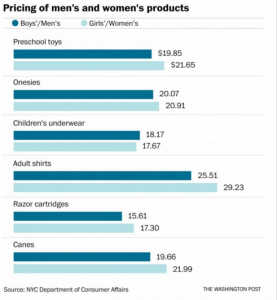It’s common knowledge that there is a disparity between men and women’s wages, but is there also a gap between the prices of products that we buy that serve the same purpose?
Products marketed to women and girls on average cost 7% more than identical products sold specifically to men. The reason so many companies are able to do this is that neither gender searches outside products marketed to them, rather they make an economical choice between brands within their gender packaging. Most astonishingly a study found that Target sold three wheel scooters, one red for $24.88, and one pink for $49.99 – aside from the color the two products were identical.
Although Target quickly changed the price after negative reactions, the biggest market that exploits gender differences is the personal grooming market. Women pay about $1,351 more annually for comparable to identical services than men.
But the numbers start to get remarkably higher when we look at the healthcare market. A nonsmoking woman often pays a higher premium than a smoking man, resulting in women paying more than $1 billion more on annual health care costs. These healthcare plans do not include pregnancy coverage either, but insurance companies claim that women utilize more services within their policy than males do.
Tariffs also play a role in this pricing; for example, men’s sneakers were taxed at 8.5%, while women’s were taxed at 10%. While the difference in costs is justification to charge a higher price, most disparities aren’t the result of a difference in input costs. This gender based pricing doesn’t only go one way, for example car insurers and nightclub owners both charge men a higher price but for different reasons.
Economists call this ability for companies to make fatter margins on a specific group’s products and services “price discrimination”. It suggests that in this case women pay more than men if and when they are less sensitive to prices. This most likely came from experimentation of manufacturers and retailers trying to raise the price of men’s products, and seeing a large decline in sales, while an increase in the price of women’s products resulted in constant sales. This is due to the fact that the majority of women are more likely to become loyal to brands, value quality, and pay the higher price.
There is and continues to be action taken to prevent companies from taking advantage of their ability to price discriminate. Under the Affordable Care Act, ten states have already banned gender rating in health insurance. In addition New York City has banned gender discrimination the pricing of services since 1998. So for services like haircuts, businesses must offer gender-neutral rates by labor intensity rather than based off of the patron’s sex.
This version of price discrimination is by no means the only one of its kind, and it will likely continue. The important thing to do as a consumer, especially females in this case, is to be aware of and not afraid to buy alternatives that may be marketed to males that serve identical purposes but just come in a different box.
